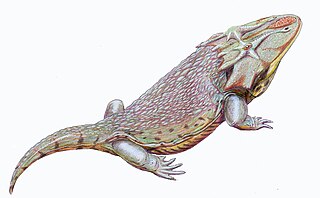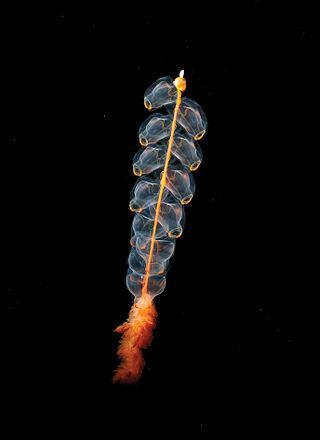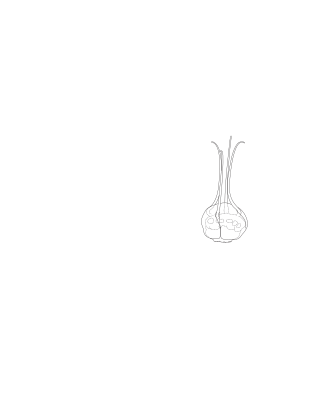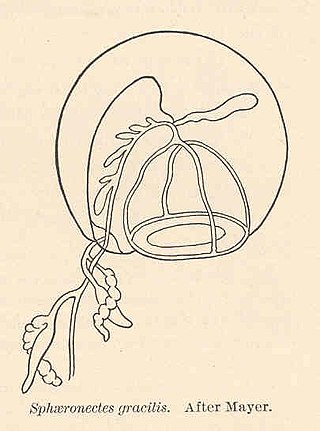
Aldous Leonard Huxley was an English writer and philosopher. His bibliography spans nearly 50 books, including novels and non-fiction works, as well as essays, narratives, and poems.

Thomas Henry Huxley was an English biologist and anthropologist who specialized in comparative anatomy. He has become known as "Darwin's Bulldog" for his advocacy of Charles Darwin's theory of evolution.

Siphonophorae is an order within Hydrozoa, which is a class of marine organisms within the phylum Cnidaria. According to the World Register of Marine Species, the order contains 175 species described thus far.
The immediate reactions, from November 1859 to April 1861, to On the Origin of Species, the book in which Charles Darwin described evolution by natural selection, included international debate, though the heat of controversy was less than that over earlier works such as Vestiges of Creation. Darwin monitored the debate closely, cheering on Thomas Henry Huxley's battles with Richard Owen to remove clerical domination of the scientific establishment. While Darwin's illness kept him away from the public debates, he read eagerly about them and mustered support through correspondence.

Rhamphocephalus is an extinct genus of fossil reptile from the Middle Jurassic Great Oolite Group of Gloucestershire, England. The name was erected as a genus of pterosaur and became a 'wastebasket taxon' for British Jurassic pterosaur remains until a recent revision. Rhamphocephalus comprises several named species, two of which are pterosaurian, but the type species - R. prestwichi - is based on remains now identified as a thalattosuchian. Because it is poorly preserved and lacks features that distinguish it from other thalattosuchians, R. prestwichi is considered an invalid species and the genus Rhamphocephalus is a nomen dubium. Reassessments of other Rhamphocephalus species suggest they are also undiagnostic to species level, although they have properties allowing referral to some Jurassic pterosaur groups.

Dolicorhamphus is an extinct genus of pterosaurs from the Middle Jurassic Taynton Limestone Formation and Fuller's Earth Formations of England. The genus contains two species, D. bucklandii and D. depressirostris.

Dasyceps is an extinct genus of zatracheidid temnospondyl from the early Permian of England.

Bothriceps is an extinct genus of stereospondyl temnospondyl. It is a member of the infraorder Trematosauria and is the most basal brachyopomorph known. It is one of the only brachyopomorph that lies outside the superfamily Brachyopoidea, which includes the families Brachyopidae and Chigutisauridae. It shares several similarities to Keratobrachyops, another basal brachyopomorph, and may be closely related to or even synonymous with it.

Lydekkerina is an extinct genus of stereospondyl temnospondyl. It is the type genus of the family Lydekkerinidae. Fossils have been collected from Early Triassic deposits in South Africa and Australia. The type species is L. huxleyi, first described in 1889. While most other stereospondyls were semiaquatic, Lydekkerina was exclusively terrestrial.

Agalmatidae, or Agalmidae, is a family of siphonophores.

Prayidae is a family of marine invertebrates in the order Siphonophorae. They are colonial, and the colonies can superficially resemble jellyfish; although they appear to be a single organism, each specimen is actually a colony of Siphonophora.

The Abylidae are a family of marine invertebrates in the order Siphonophorae. They are colonial, but the colonies can superficially resemble jellyfish; although they appear to be a single organism, each specimen is actually a colony of Siphonophora.

Apolemia is a genus of siphonophores. It is the only genus in the monotypic family Apolemiidae.

The Diphyidae are a family of siphonophores. These are colonial siphonophores with two nectophores arranged one behind the other. The front one includes a somatocyst, while the hind one does not. The somatocyst often contains an oil droplet for buoyancy control. A nectosac in each nectophore allows the organism to swim efficiently.

Aegina citrea is a genus of hydrozoans in the family Aeginidae.

The Little Drummer Girl is a British television espionage drama based on the 1983 novel of the same name by John le Carré. The six-episode series first aired on BBC One in the United Kingdom on 28 October 2018 and on AMC in the United States during November 2018.
This is a list of works by or featuring David John Moore Cornwell, a British author better known by his pseudonym John le Carré. It also includes a list of film, television, and radio adaptations of le Carré's writing.
Halistemma is a genus of cnidarians belonging to the family Agalmatidae.

Sphaeronectidae is a family of cnidarians belonging to the order Siphonophorae.
Kephyes is a genus of cnidarians belonging to the family Clausophyidae.
















